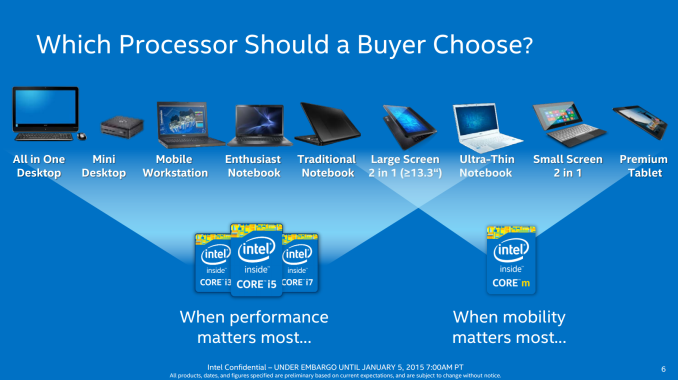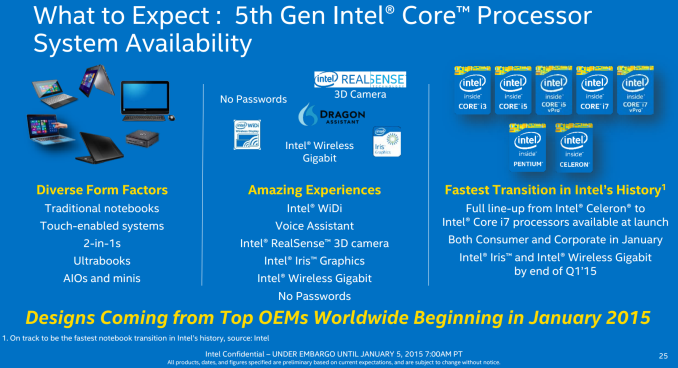Intel Releases Broadwell-U: New SKUs, up to 48 EUs and Iris 6100
by Ian Cutress on January 5, 2015 10:00 AM ESTFitting in With Core M
The staggered release of Broadwell is nothing new. Previous releases from Intel has seen them pick a particular market and aim at that first, whether it be tablet, mobile devices, ultrabooks or desktops, with the rest to follow. Core M, Intel’s 4.5 W ‘Broadwell-Y’ part, has been in the market for over a month with designs such as the Lenovo Yoga 3 Pro, although the number of SKUs available as well as worldwide distribution has been relatively slow, with the designs featuring Core M being expensive in terms of casual computing and more premium upgrades. Broadwell-U changes this by opening up the power envelope, and as such Intel sees the market at follows:
The Broadwell-U processors from Intel are aiming to give enough performance from AIO desktop systems to mini desktops, premium mobile applications all through to large 2-in-1s. There is some overlap with Core M, particularly with the 7.5W cTDP down elements of the range, but the interesting element will be pricing. The Celerons come in around $100, with the Pentium at $160, but then it gets expensive for Broadwell-U. $275 to $315 covers all the i3 and i5 parts both at 15W and 28W, ending with $393/$426 for the i7 parts. Further to my efficiency comments above, on paper at least the i5-5350U or i5-5250U would seem the most interesting processors of the bunch.
Release Dates
In our conference call with Intel, it was clear that these CPUs are shipping to their partners today. Throughout CES there will be a number of manufacturers announcing their products, and as per the norm Intel allows the partners to introduce their own products, rather than showing examples of where Broadwell-U fits in. However, because Broadwell-U is designed to be pin-compatible with Haswell-U, we might see some manufacturers purely re-releasing some of their designs with the newer CPU and a firmware update. Nevertheless, Intel is expecting OEM systems with Broadwell-U to start shipping in North America within the month. Designs with Iris graphics, or those featuring Intel based WiGig connectivity, will be more towards the end of Q1. Overall Intel is tracking ‘hundreds of designs’ involving Broadwell, indicating that it will be a significant push to bring 14nm to the market.












85 Comments
View All Comments
danjw - Monday, January 5, 2015 - link
I still not seeing any Broadwell desktop desktop parts. This continues to make me believe that Intel is having the same kind of issues with its 14nm die shrink as TSMC is with their 20nm process. Despite Intel's assertions otherwise.TiGr1982 - Monday, January 5, 2015 - link
Broadwell desktop parts are supposed to be released "Mid 2015" (May-July, maybe).There is one more Intel slide stating this (see arstechnica):
http://arstechnica.com/gadgets/2015/01/broadwell-u...
danjw - Monday, January 5, 2015 - link
How definitive! ;-) Really, this was supposed to be out early to middle of last year. This is just the latest claim of a release date from Intel. I will believe it when they are shipping them in volume. Until that it is vaporware, not hardware.TiGr1982 - Monday, January 5, 2015 - link
I agree with you, they are long overdue, in terms of previous Intel tick-tock pace. Yield problems, I guess.However, for some people like me it does not matter, because I already have Z87-based desktop since June 2013, which won't be compatible with Broadwell-K (so I'll just stick with my Z87-based setup for a while in the future).
III-V - Monday, January 5, 2015 - link
Broadwell desktop has been slated for a summer release for a good 6+ months now... Where have you been?name99 - Tuesday, January 6, 2015 - link
What problems is TSMC having with 20nm?Apple probably sold around 100M A8/A8X devices in Q4 2014.
Intel sells around 100M CPUs in a quarter, but only a REALLY tiny fraction of those were Broadwell last quarter, and even this quarter only a fraction will be Broadwell.
As far as I can see, TSMC 20nm basically hit its targets at the expected times. Intel 14nm, on the other hand has been delayed by around 6 to 9 months or so from what everyone expected. The weird slowness of the Broadwell rollout (with M then Y/U and eventually desktop) compared to previous rollouts also makes you wonder how healthy 14nm is, even today.
jjjia - Wednesday, January 7, 2015 - link
100M? 20M at most.Senti - Monday, January 5, 2015 - link
"32b INT GFLOPs" – wut? "L2 transaction lookaside buffer (TLB)" – another great one.How illiterate can you be to write that? Oh, it's Ian's article again...
toyotabedzrock - Monday, January 5, 2015 - link
I'm sorry but whoever is deciding specs and model numbers for Intel is partaking in to much medicinal weed. It gets worse every year.WaitingForNehalem - Monday, January 5, 2015 - link
So no HDMI 2.0 huh